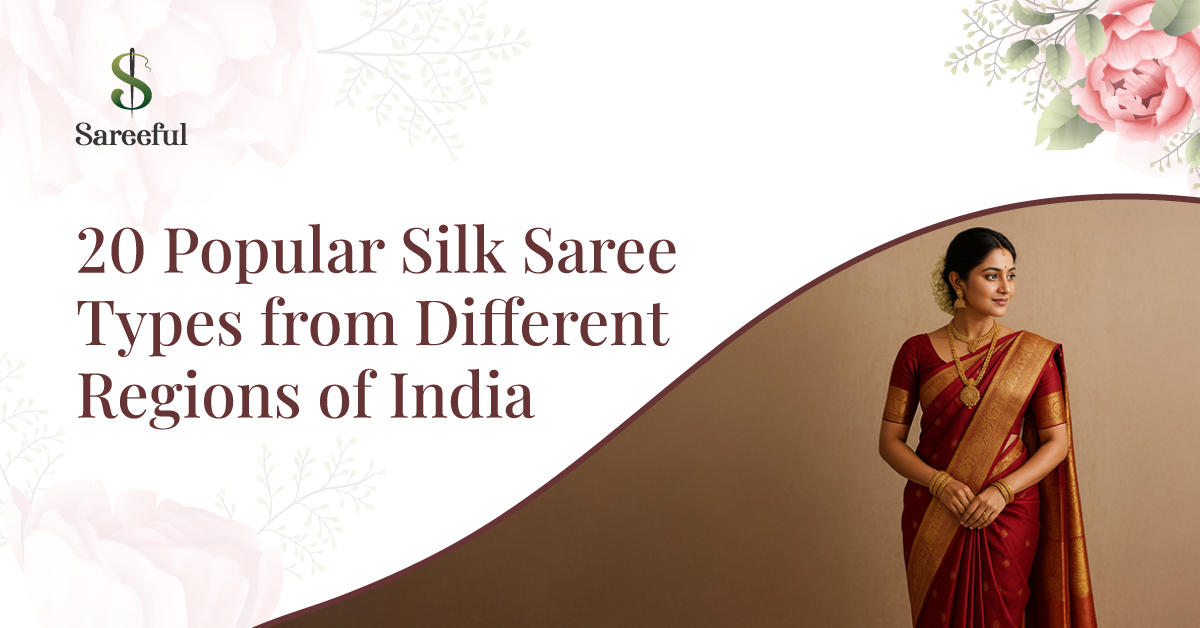
Open the door of any Indian closet, and chances are there’s a silk saree stuck in the corner, waiting for its turn in the spotlight. These aren’t mere garments, though these are geography, recollection, heritage, and artistry wrapped up into six yards.
Let’s take a wanderlust-fueled tour through the silk saree atlas of India and find out about 20 of its most breathtaking drapes.
Woven with Wonder
India isn’t just a land of cultures, it’s a loom of legacies. One glance at a silk saree, and you’re not just seeing elegance, you’re witnessing centuries of craftsmanship and local pride spun into thread.
From the regal corridors of Kanchipuram to the tribal artistry of Bomkai, silk sarees across India are more than garments; they’re stories draped in tradition and style.
Let’s tour 20 unforgettable silk sarees that show how varied and vibrant, Indian heritage truly is.
South India’s Weaving Royalty
- Kanchipuram (Tamil Nadu): Temple borders, golden-threaded legend, and imperial colors.It’s the saree that turns brides into goddesses.
- Pochampally Ikat (Telangana): Geometry is genius.The sarees boast bold ikat motifs in silk grandeur.
- Dharmavaram (Andhra Pradesh): Two colors and brocade edges like sunset and tradition rolled up together in a single fold.
- Mysore Silk (Karnataka): Light opulence with a glossy finish.Just imagine elegance, but never excessively so.
- Arni Silk (Tamil Nadu): Lesser-sung cousin of Kanchipuram, Arni lives for bright edges and high expertise.
Eastern Elegance
- Baluchari (West Bengal): Silk storybooks, with lavish stories embroidered in the pallu royal drama, epics, and folklore.
- Tussar Silk (Jharkhand/Bihar): Earthen hue and rough texture, worn by nature enthusiasts in its purest form.
- Garad Silk (West Bengal): Red and white symmetry worn during pujas a tribute to purity and tradition.
- Bishnupuri Silk (West Bengal): Silky smooth as a nursery rhyme and soft on the skin, with designs that whisper and not scream.
Northern Grace
- Banarasi (Uttar Pradesh): Mughal motifs, luxurious brocades, and timeless magnificence, Banarasi sarees are sheer poetry.
- Kota Doria (Rajasthan): Typically cotton-silk weaves, the intricately grid-like weave and feather-light texture earns it a mention here.
- Tanchoi (Banaras through Gujarat): Silk tales with Chinese roots, Tanchoi is heavy with elegant yet lavish floral and paisley motifs.
Western Whispers
- Paithani (Maharashtra): Peacock motifs and handwoven enchantment in kaleidoscopic silk, a Maharashtrian swivel to elegance.
- Patola (Gujarat): Double ikat wonders that need sheer accuracy, each piece is a woven miracle.
- Gharchola (Gujarat): Traditional bridal wear, this silk saree is nicely embellished with zari checks and auspicious motifs.
From the Heart of India & Beyond
- Chanderi (Madhya Pradesh): Delicate, light, and nearly divine.Chanderi sarees are soft as whispers but dramatic.
- Maheshwari (Madhya Pradesh): Vibrant stripes and elegant craftsmanship collide in these imperial-river inspired weaves.
- Sambalpuri Silk (Odisha): History come alive through bold dye the ikat patterns here are as vibrant as the heritage that spawned them.
- Bomkai (Odisha): Borders delicately etched with tribal motifs and dramatic ease, Bomkai is rough luxury.
Bonus Tip: How to Identify Authentic Silk
To make sure you’re purchasing genuine silk:
- Touch Test: Real silk is soft to the touch, with a very slight rustle when it’s rubbed.
- Burn Test (if you dare): Real silk burns slowly and smells like burnt hair, producing a powdery ash.
- Price & Weave: If it’s inexpensive or the weave is synthetic, chances are it isn’t.
Always buy from authentic sellers or sites like Sareeful that deal in authenticity.
Why Choose Sareeful?
Sareeful is a contemporary, handpicked haven for saree enthusiasts who enjoy tradition as much as modernity. From high-end silks to airy cottons, Sareeful presents carefully chosen sarees for weddings, celebrations, office wear, and casual wear, sorted by occasion for convenience.
Their designs juxtapose traditional craftsmanship with contemporary style, with enduring motifs, handloomed textures, and fashion-forward blouse combinations. Authenticity and quality take priority, with genuine materials such as Kanjivaram silk and Chikankari cotton.
The experience is simplistic and mobile-friendly, with uncluttered visuals and styling tips that facilitate saree shopping and make it fun. Sareeful also inspires practical styling, urging women to adopt sarees for more than just special occasions.
Wrapping It All Up
Silk sarees aren’t just about fashion. They’re heirlooms. Geographical markers. Emotions wrapped around shoulders. Each region of India doesn’t just produce silk, it produces its soul.
So when you’re rummaging around your grandmother’s trunk or oohing over something fresh off the loom, do keep in mind: you’re not wearing a saree, you’re wearing a story.
FAQs
1. Which silk saree is ideal for weddings?
Kanchipuram or Banarasi silk is the ideal choice for weddings.
2. Should silk sarees be worn daily?
Tussar and Chanderi silk are light enough to wear daily.
3. How do I maintain a silk saree?
Dry clean is suggested to keep your silk sarees pristine for long. Wraps in cotton pouches, away from the sun are also recommended.
4. Can silk sarees be dressed up?
Yes. You can pair with crop tops, jackets, or even sneakers to give a twist of your own.
5. Is handloom silk better than machine-made?
Handloom silk yields deeper texture and cultural history.
